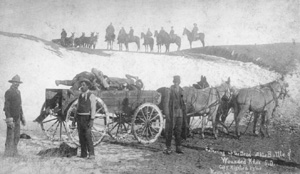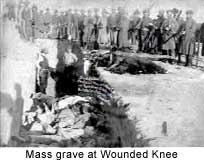Was There an 1890 School Shooting Worse than Sandy Hook ?? Yes, Indeed There Was .... US Government / OBama Big Gov. ....
The " School " in question was deemed as a place where " Indian " people, namely children, were to be Reprogramed through church avocats and goverment agencies to eraticate the indian problem. The development of "rehumanized schools" were being developed in the later part od the 1800, and continued well into the 1980s. Fact have pointed out numerous accounts of mistreatment of First Nations children, when funding or religious input subsided! This practice was deemed necessary for all Native, orphaned, mentally challanged and mixed raced children! It was a sanctioned practice by church, goverment and the millatary. Poor Blacks My Ass ...
THIS IS OBAMAS BIG GOVERNMENT PLAN,
" YE BEEN WARNED ......... "
Look at what was done to the Indians. Sad ................
Next time Al Sharpton and Jesse Jackson cry Racism,
Tell'em to go read a book about the murdered Indians !
Racist Punks All Of Them ............
Was There an 1890 School Shooting Worse than Sandy Hook?
A heavily-shared graphic claims that the deadliest school shooting was not Sandy Hook, but one that occurred in 1890 when 290 Indians were killed.
The claim is misleading. There was a massacre in 1890 but it did not occur at a school.
Let’s first take a look at what is being claimed:
Sandy Hook the deadliest school shooting in U.S. History…?
I think not. In 1890 the U.S. Government shot and killed over 290 UNARMED Indians at school, including over 200 women and children. How quickly we forget history.
They gave up their guns, too. Remember that!
Based on the assertions made above, we can only assume that this refers to the Wounded Knee Massacre, which occurred in the final days of 1890.
Wounded Knee
On December 28, 14 days after the brutal shooting of Sitting Bull, the U.S. Army sought to disarm and relocate the Lakota people, who failed to stop their Ghost Dance.
The U.S. authorities ordered the arrest of another Lakota chief, Big Foot. Big Foot’s band, which consisted mostly of women who had lost their husbands and other male relatives in battles with Custer, Miles and Crook, had danced until they collapsed, hoping to guarantee the return of their dead warriors. Big Foot and about 350 Lakota marched to Pine Ridge Reservation to seek protection from the military. At Pine Ridge they surrendered on December 28, 1890, and were escorted to Wounded Knee by the military, where they established a camp at Wounded Knee Creek.
The following morning, December 29, 1890, the military ordered all Indian weapons to be relinquished and burned. A medicine man advocated armed resistance telling the other Indians that their Ghost Dance shirts were bulletproof.
A shot was fired by an unidentified gunman.
( IT WAS FROM A GUN A SOLDIER WAS TRYING
TO TAKE FROM AN OLDER INDIAN. IDIOT ! )
On the frozen plains at Wounded Knee on the Pine Ridge Reservation, government troops opened fire on the mostly unarmed Lakota people, and massacred 290 Sioux men, women and children, including many trying to flee, in a matter of minutes. Thirty-three soldiers died, most from friendly fire, 20 Medals of Honor were presented to surviving soldiers.
Let’s take a look at the individual claims presented in the graphic, which as of this writing has nearly 50,000 shares on Facebook.
Claims
◾290 Indians Killed: TRUE. The actual number varies, but 290 is a figure sometimes used.
◾Indians were unarmed: MOSTLY TRUE. A few Lakota warriors had guns, but most of the Indians were unarmed.
◾Indians killed at school: FALSE. This event did not take place at a school.
◾Over 200 women and children killed: TRUE
◾They gave up their guns: MIXED. They were ordered to relinquish their weapons after surrendering. It is suggested that a deaf tribesman named Black Coyote refused to give up his rifle, which led to shots being fired and the escalation of the event.
Bottom Line
The Wounded Knee Massacre was a terrible tragedy in which nearly 300 mostly-unarmed Indians were killed. To categorize it as a school shooting, however, is completely without merit. BS !!
A heavily-shared graphic claims that the deadliest school shooting was not Sandy Hook, but one that occurred in 1890 when 290 Indians were killed.
The claim is misleading. There was a massacre in 1890 but it did not occur at a school.
Let’s first take a look at what is being claimed:
Sandy Hook the deadliest school shooting in U.S. History…?
I think not. In 1890 the U.S. Government shot and killed over 290 UNARMED Indians at school, including over 200 women and children. How quickly we forget history.
They gave up their guns, too. Remember that!
Based on the assertions made above, we can only assume that this refers to the Wounded Knee Massacre, which occurred in the final days of 1890.
Wounded Knee
On December 28, 14 days after the brutal shooting of Sitting Bull, the U.S. Army sought to disarm and relocate the Lakota people, who failed to stop their Ghost Dance.
The U.S. authorities ordered the arrest of another Lakota chief, Big Foot. Big Foot’s band, which consisted mostly of women who had lost their husbands and other male relatives in battles with Custer, Miles and Crook, had danced until they collapsed, hoping to guarantee the return of their dead warriors. Big Foot and about 350 Lakota marched to Pine Ridge Reservation to seek protection from the military. At Pine Ridge they surrendered on December 28, 1890, and were escorted to Wounded Knee by the military, where they established a camp at Wounded Knee Creek.
The following morning, December 29, 1890, the military ordered all Indian weapons to be relinquished and burned. A medicine man advocated armed resistance telling the other Indians that their Ghost Dance shirts were bulletproof.
A shot was fired by an unidentified gunman.
( IT WAS FROM A GUN A SOLDIER WAS TRYING
TO TAKE FROM AN OLDER INDIAN. IDIOT ! )
On the frozen plains at Wounded Knee on the Pine Ridge Reservation, government troops opened fire on the mostly unarmed Lakota people, and massacred 290 Sioux men, women and children, including many trying to flee, in a matter of minutes. Thirty-three soldiers died, most from friendly fire, 20 Medals of Honor were presented to surviving soldiers.
Let’s take a look at the individual claims presented in the graphic, which as of this writing has nearly 50,000 shares on Facebook.
Claims
◾290 Indians Killed: TRUE. The actual number varies, but 290 is a figure sometimes used.
◾Indians were unarmed: MOSTLY TRUE. A few Lakota warriors had guns, but most of the Indians were unarmed.
◾Indians killed at school: FALSE. This event did not take place at a school.
◾Over 200 women and children killed: TRUE
◾They gave up their guns: MIXED. They were ordered to relinquish their weapons after surrendering. It is suggested that a deaf tribesman named Black Coyote refused to give up his rifle, which led to shots being fired and the escalation of the event.
Bottom Line
The Wounded Knee Massacre was a terrible tragedy in which nearly 300 mostly-unarmed Indians were killed. To categorize it as a school shooting, however, is completely without merit. BS !!
THIS IS OBAMAS BIG GOVERNMENT PLAN,
" YE BEEN WARNED ......... "
THING IS THERE WAS A SCHOOL THERE.
AND WOMEN AND CHILDREN WERE MURDERED ... FOR
NO GOOD REASON ... REEDUCATION ?? SOUNDS LIKE
HILTER BOYS ...
Boy I,m so glad that nobody was ever murdered before guns were invented, there wouldn't be anyone left.
Bunch of bleeding heart liberals, the criminals already have more rights than the victims and if it's left up to you people they will be the only ones with guns. Amen
Boy I,m so glad that nobody was ever murdered before guns were invented, there wouldn't be anyone left.
Bunch of bleeding heart liberals, the criminals already have more rights than the victims and if it's left up to you people they will be the only ones with guns. Amen
Grandfathered in for now, in great britain it went like this, we dont want your shotguns, we only want your hand guns,.. then turn in your shotguns.... (although they have access to them , they are kept by the authorities) in austalia, total confiscation of all weapons. in for a penny in for a pound.
.jpg)


.jpg)

No comments:
Post a Comment